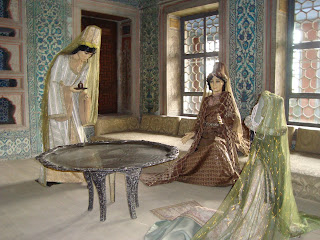 The Messina straights, Scilla on the opposite side
The Messina straights, Scilla on the opposite side Sabrina making a scylla of herself with Italian icecream
Sabrina making a scylla of herself with Italian icecream Taormina impressions at night
Taormina impressions at nightWe decided, as we left Trapani, that it was time to go home. Lots of reasons -the weather was getting hot; we were getting into high season-pricier and more crowded; and nowhere, we believed, was going to be as nice and as easy as Greece. So we settled for just one more stop, at Giardini-Naxos. Naxos is the poor seaside relation to Taormina, and it languishes at the foot of the cliffs whilst Taomina is on top.
After his dreadful experience with the Cyclops, and various other disasters Odysseus had only one ship and its crew still alive. They sailed through the straights of Messina along the east coast of Sicily until they reached the land of the sun god Helios, thought to be in the region of Taormina and Naxos. Odysseus had been warned by Circe not to kill any of the sungod's cattle, on pain of death, but his men got hungry and were persuaded by one of the crew that a big sacrifice to Helios when they got home to Ithaca would sort it. But Helios was having none of it, and made a plea to Zeus to destroy the ship, or else he would refuse to shine on the world, and go and light up the underworld instead. When the ship set sail again a terrible storm blew up and sank it and all men were lost, except for Odysseus. He was washed up on Calypso's island, thought to be Gozo, Malta and there he stayed for seven years.
The name Taormina is derived from 'Taurus' (bull) but we couldn't find hide nor hair of any cattle. This is Sicily's prime tourist location: lots of expensive hotels and shops; beaches with serried rows of umbrellas and sun loungers; and some wonderful views, with Mount Etna smoking away in the background. We stayed at a family run apartment in Naxos, much like the Greek ones we had grown to know and love. There are remains of several ancient greek settlements in Sicily, of which Naxos is the oldest. Greeks from Naxos (the greek island) and Evbea settled here around 800BC, and there is an archeological park right opposite our apartment, as luck would have it, the site of the ancient town.
In the cool of a late afternoon we visited the park, which turned out to be huge and so overgrown it was almost impossible to see the remains. A further handicap was that all the information was in Italian only. However we had one interesting find in the park museum: Greek amphoras (pottery storage jars used for transporting wine and oil etc) and other bits and pieces which had been recovered from the sea by the local sub-aqua club. The amphoras were covered with barnacles and crud and were dated 1100BC -evidence that Greek ships have been sinking off this coast at the time of Odysseus.
On our last but one day we hired a little grey car (and hang the expense) and travelled up to the Messina straights. This is the narrow sea channel separating Sicily from the toe of Italy. It's the legendary home of Scylla, the six headed monster with three rows of teeth in each mouth and twelve legs, who snatched sailors out of their ships as they passed by and ate them for breakfast. Then, if you escaped them, you were likely to be sucked down in the whirlpools of Charybdis. It was another lovely sunny afternoon when we arrived and we could see the village of Scilla, on the Italian side of the straights. There were people playing on the beach on our side and it all looked very unthreatening. Apparently there are fairly strong circular currents here, but nothing really to warrent its fierce reputation. But this a high risk earthquake zone, so it could be that the lie of the land has changed over the last three thousand years....and that still doesn't account for the monster.
We decided it was time to have a proper Italian icecream -in a brioche and head back for Palermo and the airport. Our trip was coming to an end and now we had the plane tickets, wild horses couldn't have kept us away from home. It was time.












 Andreas dancing the Rembetica in Paleochora, Crete
Andreas dancing the Rembetica in Paleochora, Crete Jim and Rachel deciphering the Phaestos Disc of Linear B. Minoan Period
Jim and Rachel deciphering the Phaestos Disc of Linear B. Minoan Period Jaane and Katerina in the Venice outfit ready for the beach
Jaane and Katerina in the Venice outfit ready for the beach Stavros just caught a baby octopus (only for show, we released off to the wilds again)
Stavros just caught a baby octopus (only for show, we released off to the wilds again)














